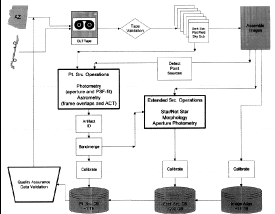IV. 2MASS Data Processing
1. Processing Pipeline Overview
Approximately 17 GB of raw digital image data are acquired each clear night at the 2MASS observatories. These data are written to DLT tape (one tape per observatory per night) and transported to the Infrared Processing and Analysis Center (IPAC). At IPAC, the observatory data tapes are read and validated, and the data is reduced using the 2MASS Production Processing System (2MAPPS). 2MAPPS is designed to exploit 2MASS's innovative data acquisition techniques to produce image, point and extended source data.
The 2MAPPS High Level Flowchart (Figure 1) illustrates the basic components of the 2MAPPS system. Data from one night and one observatory are processed as a unit. For each telescope-night, each 1 ° calibration or 6° survey scan is processed individually, with the J, H and Ks frame data in each scan processed in parallel. In general, scan data processing within 2MAPPS is a linear process with the output of each step being the input for each subsequent step. Iterations are held to a minimum for efficiency.

|
| Figure 1 |
The basic scan processing steps are the same for calibration and survey scans, and are as follows:
- Each "Read 1" (R1; 51-ms exposure) and "Read2-Read1" (R2-R1; 1.3-s exposure) data frame from a survey or calibration scan is dark-subtracted, flat-fielded and sky-illumination corrected.
- Point sources are first detected and measured on each corrected frame to provide first-order position reconstruction and frame-to-frame offsets, as well as photometry for the brightest stars.
- The frames are then combined into the Atlas Images
- Point sources are detected from the Atlas Images for maximum sensitivity.
- Positions and brightnesses are measured for each point source, and artifacts produced from bright stars are then identified in the source lists.
- Sources from the three bands are then "merged" into single sources, and final position reconstruction is carried out relative to the ACT catalog.
- Each bandmerged point source is then scrutinized to determine if it is actually resolved. Extended source candidates are characterized, deriving brightness and basic shape information.
Once all scan processing for data taken at one observatory in one night is completed, post-scan-processing is carried out. The nightly post-scan-processing steps include:
- Extract and assess photometric calibration from calibration observations
- Apply photometric calibration to point and extended sources for photometrically acceptable periods
- Verify the processing and science quality of the data
- Load source lists, images and scan information data that meet minimum Quality Assurance standards into Working Databases
The sections below provide more detailed descriptions of each of these processing phases within 2MAPPS.
Pipeline processing yields lists of band-merged, photometrically and astrometrically calibrated point and extended source "detections" from each Survey and Calibration scan. These accumulated lists constitute the Working Source Databases from which the 2MASS Point and Extended Source Catalogs are drawn. The Catalog Generation processing is described in Section V.
[Last Update: 11 February 2000, by R. Cutri]
Previous page. Next page.
Return to Explanatory Supplement TOC Page.